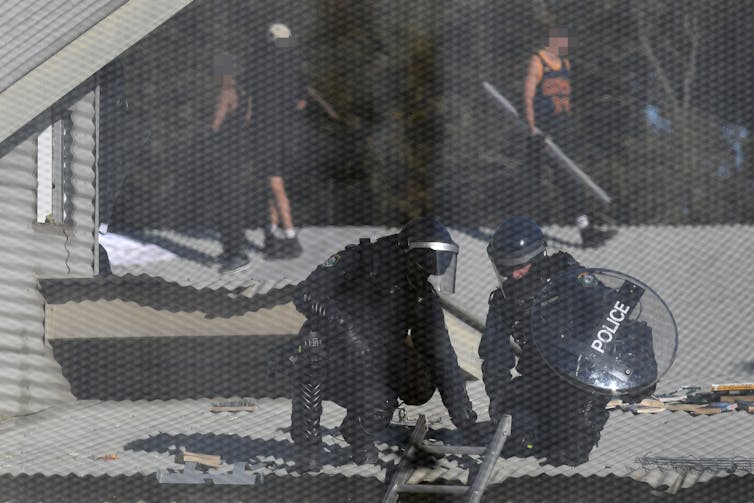Young crime is often a phase, and locking kids up is counterproductive
- Written by Joel Robert McGregor, Associate Lecturer, University of Newcastle
Last week, violent riots erupted in the NSW Frank Baxter Juvenile Justice Centre. Several inmates allegedly attacked known sex offenders, and a held a siege on the rooftop lasting nearly 22 hours. In June, officers at the centre walked off the job after a number of violent attacks by detainees.
And on average, 980 young people were in youth detention in Australia every night in the June quarter of 2018. While there has been some fluctuation in this number, there has been an overall increase in the average number of young people in detention per night since 2014.
This crowding and rising tensions have led to an Australia-wide spotlight on youth detention, which began with the 2016 ABC Four Corners investigation, “Australia’s Shame”, on the treatment of young offenders in detention centres in the Northern Territory and, in turn led to a royal commission into Northern Territory’s youth justice system.
Young people in detention often come from unstable backgrounds, their literacy levels are generally very low, they have extensive childhood trauma. On release, their prospects of employment are low. And many young people in custody are known to have experienced some form of childhood trauma, such as neglect, and physical, sexual and emotional abuse.
But research has shown young people often grow out of their offending behaviours and rejoin their local communities.
It’s time the youth justice system considered alternative community-based models that better recognise the ability for young people to abandon crime.
The juvenile justice system in NSW
In Australia, a person under the age of 10 years old cannot be charged with a criminal offence, and young person must be at least 18 to be tried in court as an adult.
The Young Offenders Act 1997 is the primary diversion legislation for young offenders in NSW. “Diversion” is used to steer young people away from involvement in the criminal justice system or deter their long-term involvement into adulthood.
Read more: Almost every young person in WA detention has a severe brain impairment
The principles of this act are to ensure there are alternative measures in place to deal with young people who come into contact with the criminal justice system. These measures include warnings, cautioning and Youth Justice Conferencing.
It’s widely accepted there are certain, more minor crimes committed disproportionately by young people, such as property crime. In these cases, young people are more likely to end up diversionary programs.
Those who do end up in custody are likely to have done so for more serious offences, for example, drug, sexual or terrorism offences, and many of the detainees have histories of violence.
While being withdrawn from the community is part of the punishment for these young people, the isolation of custody can have compounding problems upon release. As a result, there are growing calls for an overhaul of the youth justice system.
The New Zealand model
Following the recent Frank Baxter riots, Stewart Little, the general secretary of the Public Service Association, has called for a judicial inquiry. And Ruth Barson, director of legal advocacy at the Human Rights Law Centre, said the worst course of action would be a “knee-jerk and punitive” response.
 Rising tensions in youth justice centres have led to calls for an overhaul of the system.
Dean Lewin/AAP
Rising tensions in youth justice centres have led to calls for an overhaul of the system.
Dean Lewin/AAP
While reform would happen on a state-by-state basis, Australia could look to the New Zealand model to deal with young people who come into contact with the youth justice system.
The New Zealand model has a strong focus on community, and recognises that the majority of young people grow out of participating in crime.
Read more: Why are so many Indigenous kids in detention in the NT in the first place?
When a young person comes into contact with police, Police Youth Aid officers have specialised training to work with young people to divert them from the court system.
As a result, as many as 80% of young people in New Zealand are diverted from the court system.
If a young person does end up going before the court, they first undertake a Family Group Conference where the best form of intervention is determined. This process is supervised by the court and ultimately goes back before the judge for approval.
The young person is active in this process. But if they don’t comply, they must then go through a more formal process. This can take many forms, depending on the nature of the offence, such as a hearing in Youth Court or the matter may be transferred to the district court.
Read more: Ending sexual assault in youth detention centers
In part, this model is being trialled in Queensland. The families of Aboriginal and Torres Strait Islander children who come into contact with the criminal justice system are being given a greater role in family-led decision-making and Youth Justice case planning.
While custody may have a place in the youth justice system, an overhauled framework might look to place a stronger focus on the role of the community and breaking down barriers and stigmatisation of justice involved young people.
Authors: Joel Robert McGregor, Associate Lecturer, University of Newcastle


















